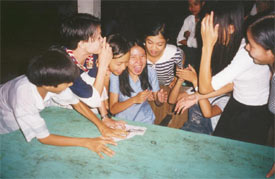Visitor Education Program:
Review 2000
Cuc Phuong National Park receives about 40,000 Vietnamese visitors each year, in addition to about 4,000–6,000 foreigners. The park’s proximity to Hanoi and status as Vietnam’s first national park contributes to its popularity amongst Vietnamese in the region. Approximately 70% of the Vietnamese visitors are students, many of these arriving in groups organized by their school or university.

The Visitor Education Program shares many of the goals of the community-based education program, except that it targets a national audience, most of which has little connection to Cuc Phuong. The program is therefore aimed at enhancing the educational value of visiting the park through provision of information about Cuc Phuong, its values and threats, as well as transmitting a more nationally focused message about the need for the public to become involved in protecting the environment and conserving nature in Vietnam.

The Cuc Phuong Conservation Project began its visitor program in 1997 with the initial printing of the park’s present tourist information brochure, provided to all visitors. The program then expanded with the development of special educational activities for student groups. However, initial efforts to present a formal educational program for visitors was restrained by poor communications (lack of an ability for student groups to organize their visits in advance), and the absence of a focal point with which to draw visitors in and provide a base for educational activities.

The Visitor Center:
A Significant Resource for Visitor Education


Children enjoy the Night Activities
Program at the Visitor Center.
|
In 1999 the project embarked on plans to establish the country's first visitor center at a National Park. The center, supported with funds from AusAID, was completed in January 2000, with current efforts focused on developing approximately 25 exhibits to provide an interesting overview of the park's natural history, its values and threats, as well as other issues relevant to nature conservation in Vietnam (e.g., the wildlife trade). The new visitors center will not only provide a resource for visitors to learn about the park and its natural history but will also serve as a base of operations for the special education programs such as the Night Acitivities Program shown above.

Although delays have prevented the center from opening as planned early in the new year, the completed center will provide a significant resource for the visitor education program and add to the project’s efforts to enhance public awareness and understanding at the national level.
|
|
Educational Visits
|
Xuan Mai Forestry College: Dr. Pham Nhat and 37 of his students from the Xuan Mai Forestry College visited Cuc Phuong National Park as part of the college’s efforts to provide students with practical field experience as part of their course structure. The project conducted several instructional sessions with students, discussing the illegal wildlife trade with particular focus on the threat to Vietnam’s turtles. Students then toured the Turtle Conservation and Ecology Center and Owston’s palm civet facilities with staff biologists Mr. Le Trong Dat and Mr. Le Thien Duc. Cooperation and training with the Xuan Mai Forestry College is viewed by the project as particularly important since many of the students will go on to be rangers after graduation, or find jobs in protected areas and parks in Vietnam.
During the evening, the project hosted a Night Activities Program featuring a role-playing exercise during which Forestry College students and visiting staff of a CARE project in Thanh Hoa Province assumed roles as major stakeholders of the park; local communities, park management, tourists, rangers, and plants and animals. During the exercise (“The Cuc Phuong Debate”) students were divided into stakeholder groups and given a brief presentation by project staff outlining the values and threats to the park. The groups then discussed amongst themselves how to work out solutions for some of the park’s conservation issues, bearing in mind that their solutions had to be acceptable to all the other stakeholders. While no solutions were reached, the purpose of the exercise was to encourage students to acquire a better understanding of the various stakeholder interests as well as the difficulty in finding solutions that meet each stakeholder’s needs.
|
|